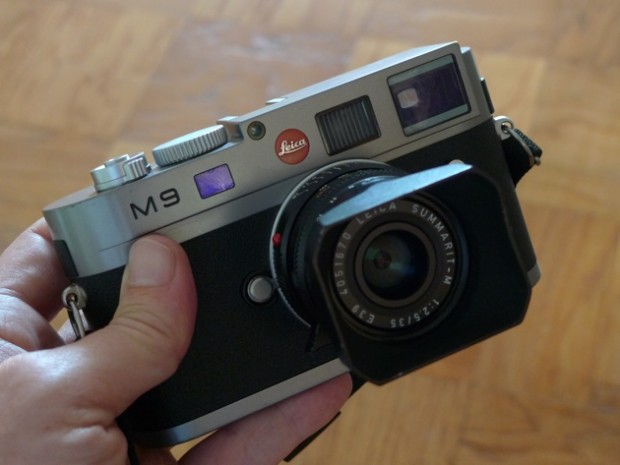
This review is by photographer Rich Svinkin.
“Nice Equipment.”
It took a second to process that the wedding photographer was talking about my camera. It was the shock of phrasing, not the awe displayed, that startled me. When I’m carrying this beauty around I get stopped by strangers all the time. Camera junkies are boundary blind like dog lovers. And like a champion breed, the M9 takes some effort to tame and train if you aren’t a professional. But if you go into it eyes open and put the effort in, get ready for blue ribbon results.
Features:
- high-resolution CCD sensor
- full 35 mm format
- compatible with any M-System Lens
- self-timer, single and continuous (up to 8 pictures in succession) exposure controls
- 2.5 inch LCD screen
- MSRP: $8000
- Product Page
Pros:
- image quality, up to 18mp
- no UV/IR filters required
- original classic design
- amazing for portraits and scenes
- lightest full-frame digital camera on the market
- Battery & SD card capacity monitoring
Cons:
- no digital preview
- manual focus using the rangefinder patch
- image quality of the auto-review
- UI controls take some getting used to
- hold and spin ISO sensitivity control
- price
- no video.
At a glance the Leica M9 resembles a camera from the 50’s and 60’s. Like most mechanical machines made back then, this newest addition to the M-System feels like it was built to last. The auditory experience makes you feel like you’ve accomplished something; it starts with a snap and ends with something akin to the raising of turrets on a battleship. But that’s just the soundtrack to an experience that may start an outright addiction to doing nothing else but taking shots with this thing. The first in-focus picture I saw on my computer made me wonder – did I really take that? Nice equipment indeed.
The M9, for all its technical achievements, like the high resolution CCD sensor which is a first for this camera size, affords a powerful but also warm, nostalgic experience, especially for those of us who took up photography before the Bush administration. But you don’t need decades of experience and schooling to use the M9 to shoot great pictures, so long as your subjects are objects at rest, not bodies in motion – the continuous shooting feature is not photojournalist strength. You do need about 7 grand, a little patience and strange as it may sound a little faith in the equipment, and yourself.
Let’s start with faith.
There’s no preview. You have to use a view finder, which relies upon a high contrast range finder patch which Leica and its retailers tout but really it’s small, for me it makes manual focusing even harder than in old film cameras where at least you had a reference line to work with. It’s like having double vision after a few drinks and trying to force yourself to sober up. So far I shoot a lot of things at a distance of infinity.
The LCD does provide auto-review after you shoot, for which you can set the duration, but it doesn’t add any confidence now matter how long you look at it because the resolution leaves a lot to be desired. Only if the picture is an outright blurry disaster will you know to delete it right away. For those that make your initial on-camera cut you simply have to wait till you get them on a computer to really see what happened. But once you do the results are impressive. If you’ve ever looked with admiration at one of your own snaps, get ready for a self-love fest. One week with this puppy and you’ll think you’re Robert Frank or Walker Evans.
Patience
If you’ve been pointing and shooting for a few years you need a week to learn or remember the classic manual controls. You not only focus manually but you adjust the f-stop the way you were meant to, by turning a ring. If you look into the lens while doing so you can see the shutter actually opening and closing, just like the old days! You can easily experiment with the shutter speed dial which ranges from 8s to 1/4000 of a second. But you’ll need to experiment because the automatic shutter speed setting often leaves you wanting more, especially when you just want the end result to look like what your eye can see.
To us amateurs the M9 affords a re-education in photography. I say embrace it rather than look for the easy ways out we’ve gotten used to with advances in point-and-shoots like the Leica D-LUX 4 which for my money is the best wide angle on the market for under a grand. Unlike the D-LUX 4 which offers a fairly intuitive user interface for a camera with sophisticated functionality the M9 UI seems like it was designed by a great music star of a genre passed by just now trying to adapt. But make no mistake the underlying design logic is cut from a timeless stone. They know what they’re doing and are willing to make difficult tradeoffs. After getting used to the interface you’ll find it easier and easier to adjust to your liking. As soon as I found the vintage black and white setting I had a vision of meeting St. Peter.
You can also read our review of the V-LUX 20 here.
The Leica M9 is deserving of its accolades and undoubtedly will earn its place in history. But be careful, if you’ve got seven or so thousand dollars to spend understand that you are getting a great camera for shooting portraits and scenes, a unique aesthetic quality in the visual imagery that only comes with a Leica lens, and a great conversation starter. If you are more interested in clearly capturing fast moving objects, having video (buy a SONY for goodness sake), or paparazzi snappiness then move along.